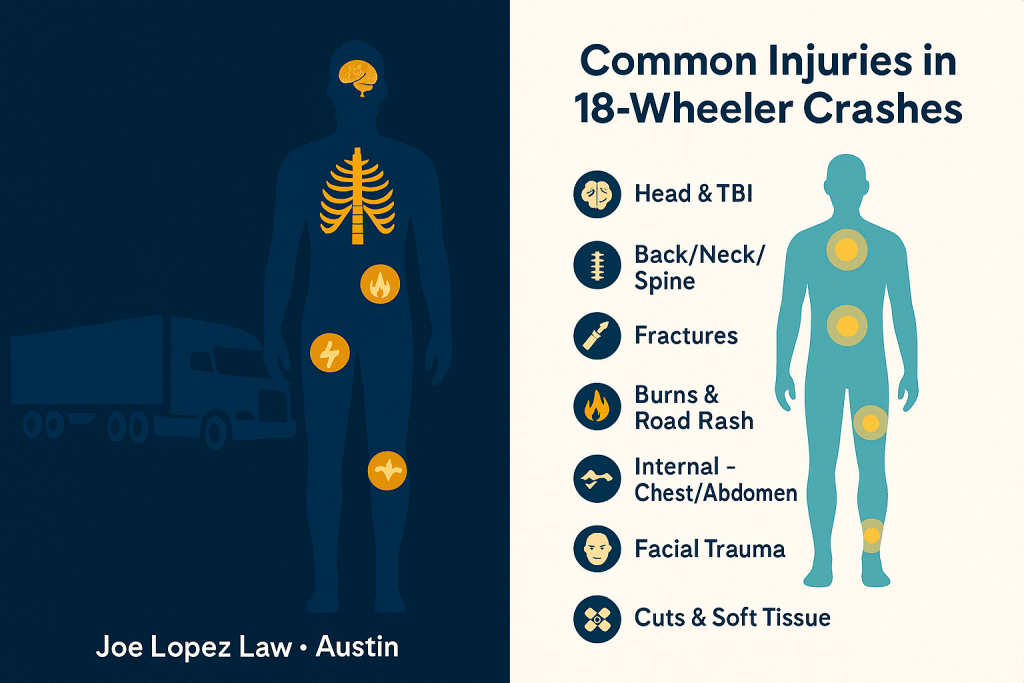If you’re reading this, you or someone you care about was likely in a collision with a commercial truck. I’m Joe Lopez, and I’ll be blunt: the injuries from an 80,000-pound vehicle don’t look anything like a typical fender-bender. They’re severe, often permanent, and they rarely resolve “on their own.” Here’s what I see most often—and why you shouldn’t downplay any of it.
Head and Traumatic Brain Injuries (TBI)
Head trauma is common in truck crashes. The force can cause concussions, skull fractures, and more serious traumatic brain injuries that alter cognition, memory, balance, mood, and sleep. Symptoms are easy to miss in the first 24–72 hours—headache, fogginess, light sensitivity—but they can signal a much bigger problem. The Centers for Disease Control and Prevention (CDC) explains that TBIs can have long-term effects on thinking, sensation, and emotional regulation. If you took a hit to the head or can’t clearly recall the crash, get evaluated immediately.
Back, Neck, and Spinal Cord Damage
Whiplash is the tip of the iceberg. I often see herniated discs, torn ligaments, nerve impingement, and in the worst cases, spinal cord injury with partial or complete paralysis. These injuries don’t just “hurt”—they limit mobility, strength, and even bladder or bowel function. According to the National Institute of Neurological Disorders and Stroke (NINDS), spinal cord trauma can cause permanent loss of sensation and function below the injury site. If your legs feel weak, numb, or “electric,” or if pain shoots down an arm or leg, you need a spine specialist.
Broken Bones and Fractures
Truck impacts commonly fracture ribs, arms, legs, pelvis, and facial bones. Multiple fractures often require surgery and hardware, followed by months of rehab—and even then, stiffness and pain can linger. The National Library of Medicine notes that complex fractures raise the risk of blood clots, infection, and long-term mobility issues. If you heard a “crack” or can’t bear weight, assume a fracture until imaging proves otherwise.
Burns and Road Rash
Fuel leaks, electrical fires, or hazardous cargo can cause severe thermal or chemical burns. Even without fire, high-speed ejection or scraping can produce deep friction burns (“road rash”). Burns aren’t just painful—they often mean skin grafts, infection risk, and permanent scarring. Document them early; scarring and disfigurement are part of your damages.
Internal Injuries: Chest and Abdomen
Internal bleeding isn’t always obvious. Blunt chest trauma can bruise the lungs (making breathing painful) and broken ribs can puncture them. Seat-belt marks across the chest or belly, abdominal tenderness, dizziness, or shortness of breath are red flags. These injuries can turn life-threatening quickly. If you feel “mostly fine” but your torso is sore or tight, don’t tough it out—get scanned.
Facial Trauma
Facial fractures of the jaw, cheekbones, and eye sockets are common when airbags deploy late or not at all, or when the cabin collapses. Beyond the obvious pain and dental issues, these injuries may affect vision, breathing, and speech—and often require multiple surgeries. The cosmetic and psychological impact is real and compensable.
Soft-Tissue Damage, Cuts, and Lacerations
Deep cuts from glass or torn metal, plus sprains and torn ligaments, are frequently dismissed as “minor.” They’re not. Scar tissue and chronic inflammation can limit range of motion and strength, affecting your ability to work or even complete daily tasks. Photograph wounds early and track how they heal—insurance adjusters often discount soft-tissue injuries unless you build a clear record.
Bottom Line
If you’re thinking, “Maybe I’m fine,” think again. Many serious injuries declare themselves late. Get medical care first, follow through on treatment, and make a record. Then talk to a lawyer who actually handles trucking cases in Austin. My job is to pressure the right defendants, preserve the black-box and maintenance data, and make sure the full scope of your losses—medical care, wages, future needs, pain, and the human impact—gets counted. If you have questions, reach out. I’ll tell you exactly where you stand.



